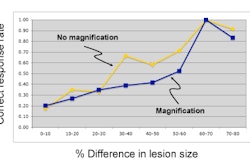After 37 months of trials and tribulations, New York-Presbyterian Hospital and Columbia University Medical Center in New York City have successfully established and validated the remote, real-time interpretation of digital mammographic images.
"Backlog time that used to be six months to schedule a case is now two days," said Dr. Alan Melton, an assistant clinical professor of radiology at New York-Presbyterian. "We did DICOM communications through two firewalls at Columbia, virtual private networks, and the cases averaged 9,500 MB per case."
Melton presented the results of the telemammography project at the 2008 American Roentgen Ray Society (ARRS) meeting in Washington, DC.
Two full-field digital mammography systems from GE Healthcare of Chalfont St. Giles, U.K., were installed at a screening facility about five blocks from the main facility at Columbia. The two locations were linked through a standard cable Internet line. In addition, a full-featured mammography workstation was located 110 miles away.
Mammogram workload
As of early April 2008, Columbia had transmitted some 36,000 cases over the Internet. "Right now every single exam done -- whether at the diagnostic center at Columbia or at the screening facility -- is all going directly to the archive ... and routed to the appropriate facility," Melton said.
Cases were transmitted in real-time without compression to the remote workstation using a commercially available cable Internet line rather than a T1 line. The cable line "is actually much faster than a T1 line," Melton added. "T3 lines are much faster than cable, but they also run around $2,000 to $3,000 a month, whereas (the cable line) is about $150 a month."
With the installation of a new router on a modem and other enhancements, such as greater bandwidth, Columbia significantly enhanced the transmission speed of the images. Two years ago, it took approximately 25 seconds for 8.7 MB of data or one image. Today, the same file size takes approximately eight seconds. Given that the average woman receives five mammographic images per exam, plus the previous five images, 10 images times eight seconds would allow a healthcare provider to access her file within 80 to 90 seconds.
With the upgrades, the telemammography system could download more than 30 cases per hour. Case turnaround, from the time images were obtained to the final report, ranged from 10 minutes to two days.
All of the images on the Columbia network adhere to DICOM standards, Melton said. Transmission abnormalities do not result in image degradation, because Columbia does not use any image compression technology. "We only had one image that suffered from degradation," he added, "and we never saw it happen again among the 36,000 images."
System upgrades
Over the last three years, Columbia has upgraded its mammography workstation from 512 KB of memory to 2 GB to access images faster. The facility also added computer-aided detection and voice dictation capabilities to the now-online report system. Reports are sent directly into the system, which conforms to the Mammography Quality Standards Act (MQSA). Once the reports are in the system, they also are sent to the patient's electronic medical record.
The system has experienced fewer than seven days of downtime over 37 months, Melton said. The stoppages were due to the replacement of the Internet cable and the installation of the mammography workstation, router, and reporting system at various times. Also, two power outages occurred due to storms, and one unfortunate spill of a coffee cup on a keyboard caused a day of downtime.
Melton said the success of this telemammography project and the advance of digital mammography in general prompt the question of whether healthcare providers should "consider establishing regional telemammography screening centers with highly skilled, tested, and dedicated radiologists and mammographers."
"Can we establish centers similar to this one," he continued, "although on a larger scale via the Internet, to remedy the impending shortage of mammographers and radiologists in light of an anticipated increase in demand?"
By Wayne Forrest
AuntMinnie.com staff writer
April 28, 2008
Related Reading
Telehealth program cuts costs, helps patients improve health, March 31, 2008
Remote island gets telemedicine capability, November 14, 2007
Alaska telehealth project improves efficiency, access to care, February 27, 2007
Internet reliable enough to transmit digital screening mammography scans, November 29, 2005
Digital telemammography trial underway at Navajo Nation, June 8, 2001
Copyright © 2008 AuntMinnie.com



















